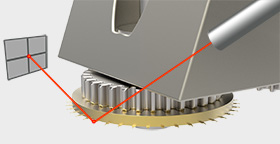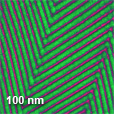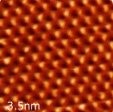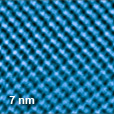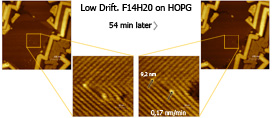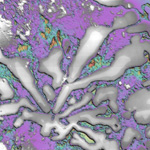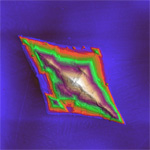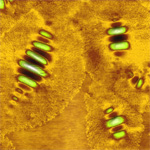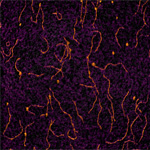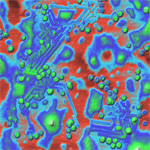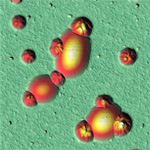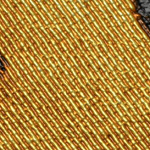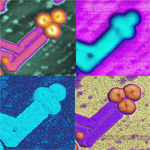產品介紹
-
-
TITANIUM
The TITANIUM Atomic Force Microscope (AFM) incorporates revolutionary developments of NT-MDT to provide the highest level of performance and ease of use. Featuring the Revolution Cartridge for Multi-probe Cartridge operation and innovative HybriD mode paired with low noise and low drift performance TITANIUM sets a new standard in atomic force microscopy.
產品說明
The Highest Performance AFMThe TITANIUM Atomic Force Microscope (AFM) incorporates revolutionary developments of NT-MDT to provide the highest level of performance and ease of use. Featuring the Revolution Cartridge for Multi-probe Cartridge operation and innovative HybriD mode paired with low noise and low drift performance TITANIUM sets a new standard in atomic force microscopy.
|
Revolution Cartridge
|
High Resolution Imaging
|
Main features
|
Advanced characterization techniques
|
產品應用
| With its wide variety of techniques and modes of probe measurements, the TITANIUM measurement complex is applicable for many challenges in science and technology. Scanning with atomic resolution that by TITANIUM can offer is of high demand in physicochemical research of solid surfaces, low-dimensional nanostructures, and nanomaterials. Surface morphology analysis provides parameters of roughness, texture, and anisotropy of the sample surface as well as distributions of adsorbed particles and geometrical characteristics of those particles. Dedicated gentle scanning techniques are now available to study powders, soft materials, biological structures, biomolecules, biopolymers, and to perform measurements in liquid. |
A peculiar place in applications of TITANIUM is taken by material science. It includes study of adhesion characteristics, friction factors, wear resistance of coatings, elasticity moduli, hardness etc. Wide variety of techniques for measurement of electrical characteristics implemented in TITANIUM (local resistance, surface potential, capacitance, photovoltaic parameters) enables analysis of various functional structures, components of micro-, nano- and molecular electronics, and sensors of many types. TITANIUM offers comprehensive capabilities to study ferroelectrics in terms of their domain structure, hysteresis properties, and thermal characteristics. |
產品規格
| Measuring heads Revolution Cartridge for Multi-probe Cartridges. Enables Automated Cantilever Replacement with Full Tuning Standard AFM Head for traditional single chip probes for traditional AFM cantilevers. Enables operation with the majority of commercial probes AFM Head for Liquid Studies STM Head Scanner Type: Tube Scanner with Closed Loop Sensors, Scanning by Sample Scanning range, XYZ: 100×100×10 or 2×2×0.2 in Low Voltage Mode Closed loop: Available for all Directions: XYZ Noise: <300 pm in XY and <30 pm in Z for Closed Loop, <30 pm in XYZ for Opened Loop Drive electronics noise < 5 uV/√Hz Tip-Sample Positioning Type: Motorized Sample positioning in XYZ XYZ Thermal Drift: <0.2 nm/min Moving Range: 5×5 mm in XY, 10 mm in Z Navigation: Place of Interest Saving, Navigation by Mouse Click on Video Image, 3D Mouse Compatible, Automated Multiple Scanning Approach: Smart Soft Approach Algorithm View Module Type: Motorized Focus, Zoom and XY positioning. Calibrated with Sample and Laser Position Resolution: 2 μm Field of View: up to 2×2 mm (1 Mpixel), up to 7×7 mm using automated panoramic optical view (50 MPixel) Autofocus: on Cantilever, on Sample Video Recognition: Cantilever Position Zoom: Motorized Continuous Optical Zoom Accessories AFM Liquid Head: Contact mode, AC mode, HybriD mode, Spectroscopy STM Measuring Head: Constant Height and Constant Current Topography, Barrier Height, States Density, I(V) Curves, I(Z) Curves Nanoindenter Measuring Head: Sclerometry, Indenting, Measuring Approach Curves. Range of Measured quantitaties: 1‑80 GPa for Hardness, 1-1000 GPa for Elasticity modulus Heating Stage: from RT to 150 0C Signal Assecc Module +/- 50 V Voltage Extender AFM tips: Variety of Single Chip AFM Cantilevers Multi-probe Cartridges with 38 cantilevers of different types and coatings |
Electronics & Software Number of scan channels: virtually unlimited. More than 16 independent simultaneous scan channels supported Signal Processing: 512 Mb Buffer Size, 3x 340 MHz FPGA, 320 MHz DSP Lock-in Amplifiers: 2x Analog Lock-in Amplifiers, 3x Digital Lock-in Amplifiers (Multifrequeny AFM modes supporting) Generators: 6x 32 bit Digital Generators, 4x for Lock-in BV: +/- 10 V AC and DC (Independent Sample and Tip Voltage Supply), +/- 50 V AC and DC (Optional) Self-testing: automated performance check Maximum Scan Points: 8000×8000 Points Scanning Parameters Auto Adjustment: Driving Amplitude, Lock-in Gain, Setpoint, Feedback Gain, Scanning Rate, Advanced Modes Configuration Automation Features: Optical System Adjustment, Multiple Scanning on 5×5 mm Range with Scan Stitching, Overlay of Optical and AFM images , Panoramic Optical View, Place of Interest Saving, Autofocus on Cantilever, Autofocus on Sample Programming tools: Nova PowerScript Language, LabView Integration Optical Sensor Light source: 850 nm Optical System Adjustment: Automated in Air and Liquid Optical Beam Deflection Sensor Noise: <25 fm/√Hz above 100 kHz Instrument Isolation Thermal Stabilization: Temperature Control in Acoustic Enclosure Acoustic Isolation: Acoustic Enclosure, Motorized Build-in Protective Cover Seismic Isolation: Active Vibration Isolation Table Routine Atomic Resolution: in air and liquid Basic Set of Modes Contact mode: Topography, Lateral Force, Force modulation, Spreading Resistance, Multifrequency Piezo Force Microscopy, Contact Resonance Microscopy Amplitude modulation mode: Topography, Phase Imaging, Single and Double Pass Kelvin Probe Force Microscopy with Phase and Amplitude Modulation, Double Pass and Lift Magnetic Force Microscopy, Single and Double Pass Electrostatic Force Microscopy, Single and Double Pass dC/dZ and dC/dV microscopy HybriD mode: Topography, Elasticity modulus, Lift and Land Adhesion, Work of Adhesion, Current, Viscoelasticity Nanolithography: Voltage, Current, Force (All Vector and Raster), Nanomanipulation Spectroscopy: Force-, Amplitude-, Phase-, Frequency-, Current-Distance, I(V), Piezopulse, Custom mode |


